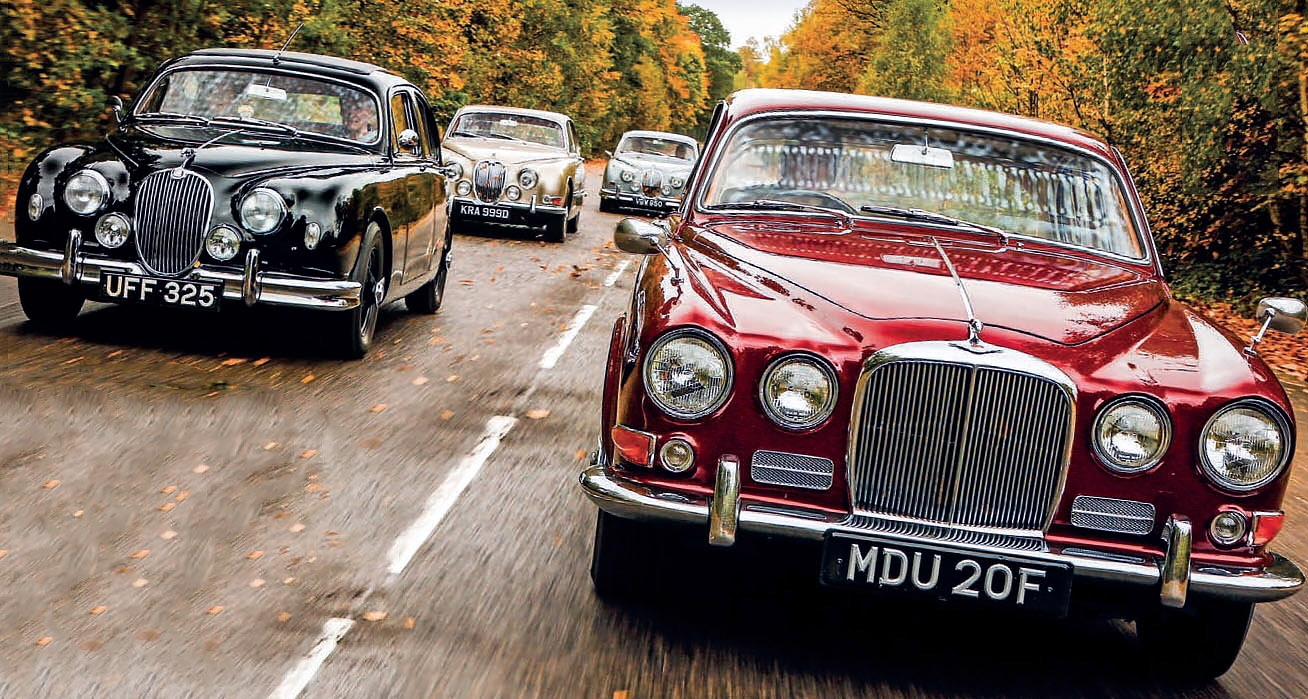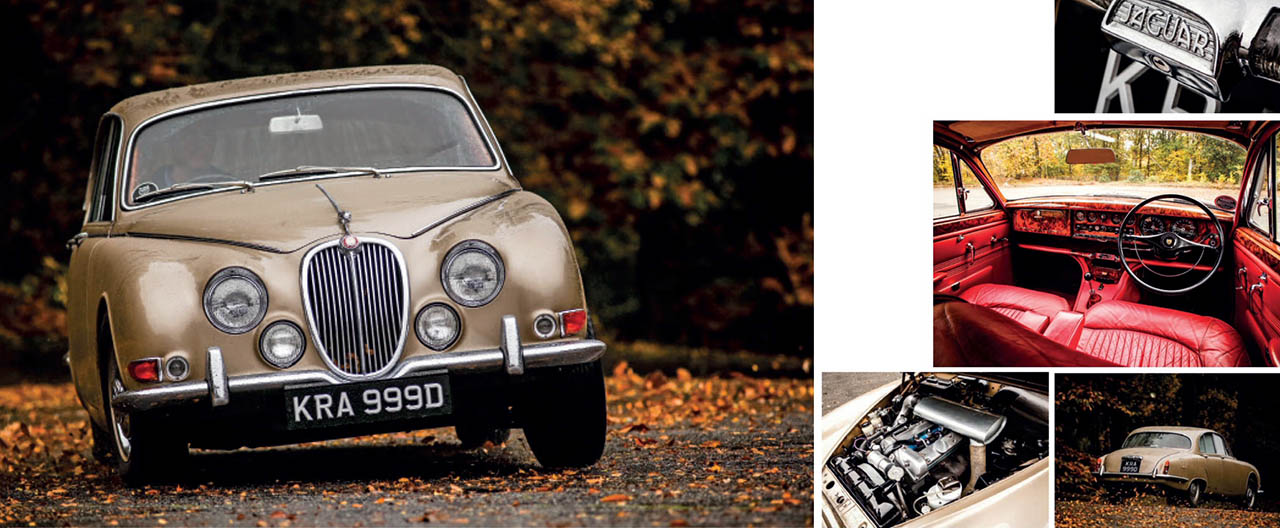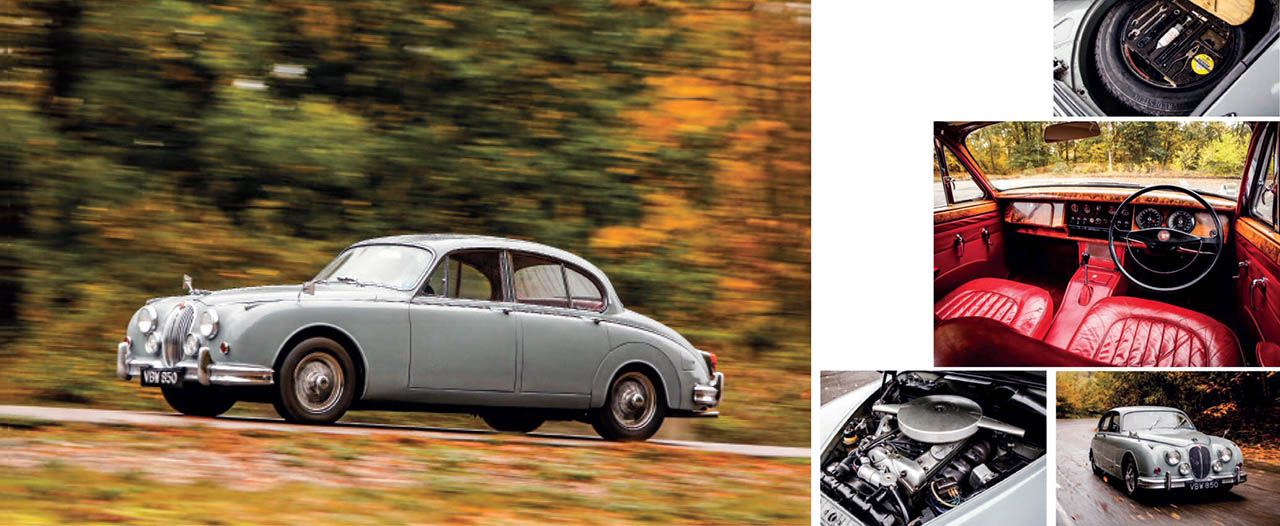
Jaguar’s all-conquering compacts. With the Mk1, Mk2, S-type and 420, Browns Lane created one of the greatest ever saloon car bloodlines, says Martin Buckley. Photography Tony Baker. Jaguar Legends Regeneration Game. Stylish, sporting, affordable saloons, from Mk1 to 420 Jag’s first family of saloons: Mk1, Mk2, S-type and 420. Coventry’s top compacts Buckley drives Jaguar’s fabulous line of saloons, from the Mk1 to the 420.
Many fortunes have been squandered in the pursuit of exotic car manufacture over the years. What made Jaguar’s founder Sir William Lyons different was that he wanted to build an exciting range of vehicles but had no intention of losing money.

If it was the XK sports cars and racing success that put Jaguar on the map in the 1950s, it was these compact, unitary saloons – Mk1, Mk2, S-type and 420 – that cashed-in throughout the more affluent and increasingly status-driven ’60s. Their function was to give the volume and economies of scale that Lyons needed for his firm to grow, a role that they accomplished admirably.
This quartet represents a 13-year dynasty of 160,000 cars and four distinct but closely linked models that today encapsulates most people’s idea of what a classic Jaguar saloon is all about. The original 1955 concept of the 2.4 was for a smaller ‘economy’ Jaguar in the mould of the old 1½ and 2½ litre SS saloons. Conceived to fill a gap in the range between the XK and the big MkVII, visually the new saloon had something of the appeal of both. Lyons understood the value of giving his cars a family look of lean, sophisticated glamour – something that buyers struggled to find anywhere else at any price, never mind the £1268 he was asking for the standard model.
Through to 1957, the ‘compact Jaguar’ was available only with the short-stroke 2.4-litre engine, 50lb lighter and 3in shallower in the block than its longer-stroke siblings. On 112bhp it could take the 2.4 to 60mph in 14 secs and push it to more than 100mph, so it was no weedy poverty model. It was, in fact, as fast as an automatic MkVII, although not all that much more economical at 18-23mpg.
It was, in any case, performance not economy that motivated Jaguar buyers, so a 3.4-litre version of the ‘compact’ was perhaps inevitable. Outwardly identifiable by its larger grille (with thinner slats) and cutaway rear spats, the 1957 3.4 was a spectacular car, able to keep up with an XK140 and, probably, most other production four-door saloons in the world. With the B-type cylinder head, this 210bhp car was good for more than 120mph; specify the right combination of axle ratio (there were three to choose from) and optional Laycock overdrive and it could cruise at 106mph showing just 4000rpm. A Dunlop disc brake option answered early concerns about stopping power, but the 3.4 retained the curiously narrow rear track of the smaller-engined car. At 4ft 2¼in, it spanned less of the road than a Morris Minor.
Anthony Gilensen’s black Mk1 (the designation was used only retrospectively) is a slight cheat because it is running a 3.8-litre engine, Mk2 rear axle and disc brakes. Bought as a barely running restoration project in 1994, UFF 325 is now smart enough to feature in the Endeavour television series (the prequel to Inspector Morse) as the hero’s squad car.
While it is undoubtedly faster than it would have been in ’58 (when it started life as a humble 2.4), it provides the atmosphere of the early compacts. The Smiths instrumentation is clustered on a walnut slab that forms the centre of the dash, while the various light, heater and wiper controls are scattered randomly around them. The view out is restricted, particularly through the slot-like rear window. The model was penned in the early days of monocoque technology and you can see the body engineers’ caution in the thick front screen pillars, too. But this relatively light, stiff unitary shell was the firm’s greatest (and most expensively developed) technical achievement since the creation of the XK engine and, with its slender individual front seats, the Mk1 is almost as roomy internally as the bulky MkVII.
Thanks to the clever and pioneering deployment of rubber bushing (plus a front subframe to isolate the new ball-jointed coil-spring and double-wishbone suspension) the Mk1 is refined for a ’50s monocoque, remarkably bereft of irritating tyre, road or suspension-generated noise.
You can see some of the other reasons underneath. At the rear, its live axle is hung off cantilevered semi-elliptic springs located inside the chassis rails so as not to feed unknown stresses into the boot floor. Further examination reveals that everything is tied together by myriad box-sections and deep longitudinal sills (with a legendary propensity for rot). From the first 2.4 in 1955 to the last 420 in 1968, it was Pressed Steel of Swindon that supplied the shells to Browns Lane, complete with weldedon inner and outer wings.
After 37,000 Mk1s had been built, Jaguar refreshed the concept with the Mk2 range at Motor Show time in 1959, setting the ‘compact’ template for the coming decade and creating probably the best-loved British saloon to date. A 220bhp 3.8-litre option joined the 2.4 and 3.4 in an airier body that featured larger front and rear screens, plus doors with slim chrome-window frames rather than the heavy looking full pressings of the earlier car. Across the range, the Mk2s were only £135 more than the cars they replaced.
The cutaway rear spats and deep bumpers were much as before, but the tail-lights and the quarter windows in the rear doors were new. The much less gloomy interior was completely restyled, placing the main instruments in front of the driver behind a smaller 17in steering wheel. Twelve-inch disc brakes were standard on the Mk2, and the rear track was increased by 3¼in. In the aftermath of the bad publicity surrounding the death of Mike Hawthorn in his Mk1 on the Guildford Bypass just a few months earlier, this looked like a quiet admission that the original axle had been on the narrow side.
Raising the front roll centre made the Mk2’s steering lighter, although it was still low geared overall – even when power steering became available later. This, the feeble heater and recalcitrant Moss gearbox would be oft-repeated Mk2 whinges throughout the ’60s, although they were not enough to deter almost 100,000 buyers from what was undoubtedly the best-value high-performance luxury saloon in the world.
The 3.8, with its standard Powr-Lok limited-slip differential, would get to 60mph – still only in second gear – in 8.5 secs and smash the standing quarter in 16 secs. Even an automatic 3.4 could crack 120mph but somehow the Cinderella 2.4, despite its new B-type head, couldn’t make the ton – which is probably why Jaguar never officially released one for test.
Peter Houghton’s beautifully preserved 3.4-litre, manual overdrive Mk2 in Mist Grey was sold new in 1962 to a farmer near Swindon; Houghton acquired it from dealer Robert Hughes in 2012 to replace a Big Healey.
The interior is brighter and more appealing than that of the Mk1, with a more logical dash, armrests on each door and all the right smells from the original leather. Furthermore, the handsome veneers that are 50% of the appeal of these cars even extend to picnic tables in the seatbacks. The toggle switches look intimidating but are arranged with a certain logic and are soon learnt.
Being a Moss ’box car with low-geared manual steering, this is the raw Mk2 experience. Dip the hefty clutch and, as in the Mk1, there’s that long movement of the lever into first plus the classic whine from the straight-cut gears as the car gathers pace energetically from 1500rpm, and a burble of subdued aggression from the twin exhausts.
Sweet changes require slow movements but the action is satisfying and somehow well matched to the hefty steering that lightens beyond 40 or 50mph. The Mk2 has great straight-line stability and is set up to understeer – for the best results, you turn in early and then let the strong self-centring slide the smooth, flat-spoked wheel through your loose grip.
Shapeless seats betray the degree of roll as much as the angle of the horizon – one area where the Mk1 is probably better. But there’s a limousine-like smoothness to the drivetrain for seamless low-speed running and, once under way, little need to change gear – most situations can be dealt with by flicking in and out of overdrive.
The S-type was an all-independently suspended car that supplemented the Mk2 from 1963 and was phased out in ’68. With its beefedup chassis to take the quad-damper IRS (adapted from the E-type and MkX) it was a necessarily heftier car than the Mk2, with the emphasis on luxury, MkX-style. It was calculated to capture those buyers who were proving resistant to the sheer bulk of Jaguar’s flagship saloon but who appreciated its suspension refinement.
The S-type’s elongated rear wings accounted for a seven-inch increase in length and provided space not only for a bigger 19cu ft boot, but also seven-gallon pannier fuel tanks in the wings with a changeover switch on the dash.
The doors were from the Mk2 but a subtly longer, flatter roofline flowed into a more upright rear window to improve headroom. Similarly, the bonnet was pure Mk2 but the new hooded headlamps and a thicker grille surround somehow had the effect of making the S-type look a bigger and more important car. Details such as slimline bumpers and recessed indicator and sidelight units, meanwhile, made it appear cleaner and more modern.
I have to confess to having a slight preference for the S-type. Driving Robert Hughes’ fabulous low-mileage Golden Sand example (it’s so nice, he is keeping it for his personal collection) only reaffirmed my respect for the car. It is a lot more than just the hoodlum’s hot rod that its The Sweeney image leads you to believe. This was one of the most refined and agile saloons in the world in the 1960s, regardless of price.
A 3.8 manual S-type such as this one has about the performance of a 3.4 Mk2, but with the power steering and full synchromesh that most (but by no means all) of them had, it feels that much more manoeuvrable and handy. There is more ultimate grip from the wider-track IRS, which, with its isolating subframe, alloy hubs and halfshafts doubling as upper control arms, enables the car to flow along the road with admirable serenity. The steering makes up for its lightness by having far fewer turns between locks, while the brakes, in common with all ’60s Jaguars, are brilliant; the car just stops when required and you don’t really need to think about them.
This one has a particularly good, quiet gearbox with perfectly spaced ratios, and the ride is superb. It feels expensive in the way it demolishes ridges and potholes and the S-type just seems more substantial than the Mk2. That said, you don’t consider the earlier car to be in any way primitive until you drive an S-type.
The cabin has more of a boardroom feel than the Mk2, with armrests for the more substantial front seats, an oddments shelf under the dash and a centre console that flows neatly into it. The latter houses the radio speaker as well as vacuum controls for the heater.
While other marques rationalised in the mid-’60s, Sir William Lyons continued to mix and match his bodies and engines – presumably to extract value from his tooling investment. Thus, when the 420 was launched in 1966, Jaguar continued to offer the S-type and Mk2, as well as the new 420G – an improved MkX.
What the 420 – one of the rarest Jaguar saloons – represented was a holding operation while the XJ6 was in preparation. It took the compact concept further down the executive route with what was in effect a more modern and luxurious S-type powered by a 4.2-litre, 245bhp version of the XK engine.
MkX-like with its quad lights and commanding grille, the front-end sheet metal of the 420 was all-new and had the additional benefit of making the twin-SU fed engine – now with an alternator and fluted cam boxes – more accessible. The latest Borg Warner Model 8 automatic was a favourite option on the luxury-focused 420, but the four-synchromesh manual was optional and made the car nearly as quick as the 3.8 Mk2.
This one – kindly loaned by one of Hughes’ customers – is an automatic, to which the torque characteristics of the longer-stroke engine are particularly well suited. With its padded dashtop and quiet engine restrained by the torque converter of the improved auto ’box, the 420 feels just one step removed from the hyper-civilisation of the XJ6 – the model that swept the ‘compacts’ into history when it was unleashed in October 1968.
The engine is possibly not quite as willing as in the earlier cars, but you would never knock it for that. With its lusty kickdown and slightly jerky full-throttle changes, this is a decidedly potent ’60s saloon that gives the sort of effortless acceleration that American buyers demanded. It was also the last Jaguar saloon to have a columnchange automatic and the last – until the modern era – with a separate starter button.
The compact Jaguars became great symbols of personal achievement in the ’60s. They had a turn of speed that was almost immoral at the price and a level of luxury probably surpassed only by the products of Crewe (at three times the money), yet they were accessible. Your dad – or somebody your dad knew – could actually dream of having one.
If a Mini was classless then a Mk1, Mk2, S-type or 420 created its own category, putting true high performance into the hands of the moderately well off rather than just the extremely wealthy – although many very well-heeled people bought them when they could easily have afforded something flashy and foreign at twice the price. These were cars that crossed the divide between bookmaker, gangster and peer of the realm.
A ubiquitous sight in British traffic, in Mk2 form they became equally synonymous with racing success – in the hands of Hill, Sears, Salvadori and many others – as they were in the world of crime. Villains loved these small Jaguars for their speed, manoeuvrability and, to be honest, the ease with which they could be stolen. The police had to have them, just to keep up.
‘THESE COMPACT JAGUARS WERE CARS THAT CROSSED THE DIVIDE BETWEEN BOOKMAKER, GANGSTER AND PEER OF THE REALM’

Above: same basic bodyshell, but regular updates kept the styling fresh over a 13-year career; squared-up front with quad lamps would survive until 1992 on Daimler Limousine. From top: 420’s front seats incorporate substantial armrests; improved underbonnet access thanks to restyled nose; padded dash and less wood in cabin; tail shared with earlier S-type.

Clockwise, from main: hooded headlamps, slimmer bumpers and revised indicators identify the S-type; bigger seats and more timber in cabin; reversing lights built into stylish plinth; extended tail offered increased luggage space while IRS improved handling and ride; potent 3.8-litre ‘six.
‘A 3.8 MANUAL SUCH AS THIS ONE HAS THE PACE OF A 3.4 Mk2, BUT IT FEELS MUCH MORE MANOEUVRABLE’

Clockwise, from main: more glass, chromed window frames and bigger tail-lights lend the Mk2 a more modern profile; revised dash places main dials ahead of driver; neat toolbox fits inside spare; wider rear track improved stability at speed; 3.4 is the sweetest version of Jaguar’s superb XK engine.
‘THE Mk2 WAS UNDOUBTEDLY THE BEST-VALUE HIGH-PERFORMANCE LUXURY SALOON IN THE WORLD’

Above: beautifully appointed XK-style dash with central dials and nonstandard wood-rim wheel; 3.4 (pictured) has larger grille than 2.4 – note oval indicators compared to the round units on Mk2. From top: period Britax lap-belts; later 3.8-litre ‘six’ in this car; letterbox rear window and heavy pillars on Mk1 betray the designers’ caution when creating the firm’s first monocoque saloon.
‘IT WAS PERFORMANCE NOT ECONOMY THAT MOTIVATED BUYERS, SO A 3.4 WAS INEVITABLE’





